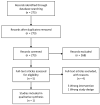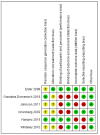The Effect of a Combined Gluten- and Casein-Free Diet on Children and Adolescents with Autism Spectrum Disorders: A Systematic Review and Meta-Analysis
- PMID: 33573238
- PMCID: PMC7912271
- DOI: 10.3390/nu13020470
The Effect of a Combined Gluten- and Casein-Free Diet on Children and Adolescents with Autism Spectrum Disorders: A Systematic Review and Meta-Analysis
Abstract
There has been a growing interest in the gastrointestinal system and its significance for autism spectrum disorder (ASD), including the significance of adopting a gluten-free and casein-free (GFCF) diet. The objective was to investigate beneficial and safety of a GFCF diet among children with a diagnosis of ASD. We performed a systematic literature search in Medline, Embase, Cinahl, and the Cochrane Library up to January 2020 for existing systematic reviews and individual randomized controlled trials (RCTs). Studies were included if they investigated a GFCF diet compared to a regular diet in children aged 3 to 17 years diagnosed with ASD, with or without comorbidities. The quality of the identified existing reviews was assessed using A Measurement Tool to Assess Systematic Reviews (AMSTAR). The risk of bias in RCTs was assessed using the Cochrane Risk of Bias Tool, and overall quality of evidence was evaluated using Grades of Recommendation, Assessment, Development, and Evaluation (GRADE). We identified six relevant RCTs, which included 143 participants. The results from a random effect model showed no effect of a GFCF diet on clinician-reported autism core symptoms (standardized mean difference (SMD) -0.31 (95% Cl. -0.89, 0.27)), parent-reported functional level (mean difference (MD) 0.61 (95% Cl -5.92, 7.14)) or behavioral difficulties (MD 0.80 (95% Cl -6.56, 10.16)). On the contrary, a GFCF diet might trigger gastrointestinal adverse effects (relative risk (RR) 2.33 (95% Cl 0.69, 7.90)). The quality of evidence ranged from low to very low due to serious risk of bias, serious risk of inconsistency, and serious risk of imprecision. Clinical implications of the present findings may be careful consideration of introducing a GFCF diet to children with ASD. However, the limitations of the current literature hinder the possibility of drawing any solid conclusion, and more high-quality RCTs are needed. The protocol is registered at the Danish Health Authority website.
Keywords: autism spectrum disorder; childhood; gluten-free/casein-free diet.
Conflict of interest statement
The authors declare no conflict of interest.
Figures










References
-
- Autism Spectrum Disorders. [(accessed on 27 January 2021)]; Available online: https://www.who.int/news-room/fact-sheets/detail/autism-spectrum-disorders.
-
- Buie T., Campbell D.B., Fuchs G.J., Furuta G.T., III, Levy J., Vandewater J., Whitaker A.H., Atkins D., Bauman M.L., Beaudet A.L., et al. Evaluation, diagnosis, and treatment of gastrointestinal disorders in individuals with ASDs: A consensus report. Pediatrics. 2010;125(Suppl. 1):1–18. doi: 10.1542/peds.2009-1878C. - DOI - PubMed
Publication types
MeSH terms
Substances
Grants and funding
LinkOut - more resources
Full Text Sources
Other Literature Sources
Medical

